
Magnolias: 7 companion planting ideas
How to pair your magnolias in the garden or on the terrace
Contents
The Magnolias are among the most beautiful spring- and summer-flowering trees. Their cup-, goblet- or star-shaped flowers never fail to astonish each season. There are more than 80 species, deciduous or evergreen. Each brings a different style to a garden through its colours, the shape of its flowers or its foliage. While truly elegant on their own, Magnolias can be paired with many types of plants, because their flowering is short-lived, and it is interesting to include them in planting schemes with Japanese, exotic or natural themes, and even in large container plantings on a terrace for the most compact varieties.
Discover how to showcase your Magnolias alongside other bushes or perennials.
In a Japanese garden
Magnolias’ refinement makes them a classic feature of Japanese-style gardens, where their delicate flowering is superbly showcased in early spring. These acid-soil bushes are truly the stars of Japanese-inspired settings, and they will be in your garden too, whether in a dedicated bed or, of course, a 100% Japanese garden. Ideally chosen small in size or with a spreading habit to confer volumes characteristic of Japanese gardens, you can, for example, plant a Magnolia stellata ‘Water Lily’ or a Magnolia loebneri ‘Leonard Messel’ as a base favouring soft tones. Once past bloom, your small tree should be surrounded by plants with strong visual presence, but keep layout restrained to maintain that very pared-back harmony.
Paired with twisted dwarf pines, or trained as cloud-pruned niwaki, an Acer palmatum dissectum ‘Atropurpureum’ with laciniate purple foliage, and some Japanese Azaleas to prolong splashes of colour into May, you instil a very zen note. Add several mat-forming perennials such as Ophiopogons planiscapus ‘Nigrescens’ around a rockery to perfect this setting conducive to meditation. In a larger space, feel free to include some Pieris for year-round foliage interest, Peonies, one or two trees such as a Japanese cherry, and some low, airy perennials like Hesperis matronalis for summer.
Explore a wider range of plants to create your Japanese garden
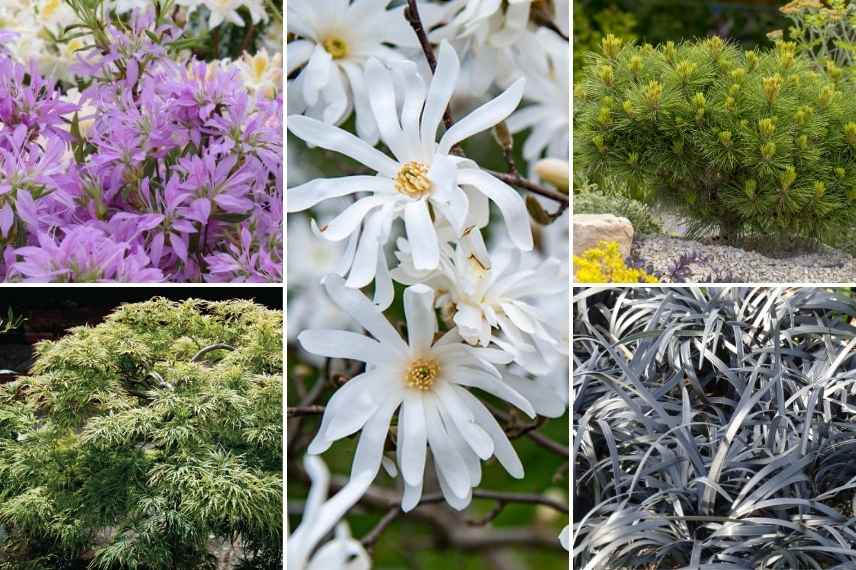
A Magnolia stellata surrounded by a Japanese Azalea ‘Koromo Shikibu’, an Acer palmatum dissectum, a twisted dwarf pine and some Ophiopogons planiscapus ‘Nigrescens’
Read also
Magnolias: planting, pruning and careIn an exotic flower bed
Evergreen Magnolias with glossy, leathery foliage contribute to a strongly exotic feel. They are very interesting to use in this spirit, where they lend strong presence to tropical scenes thanks to their large glossy leaves. Do not multiply the essential oils you associate; a mass planting of a groundcover and one or two mid-sized perennials will produce a fine sensation of plant luxuriance and will showcase your Magnolia.
Pair, for example, a Magnolia grandiflora ‘Alta’ whose habit remains narrow with other large glossy foliage such as Acanthus, which will flower for a long time on tall mauve spikes, and the surprising Eucomis adding another very exotic note in late summer. A tapetum of Farfugium japonicum, Bergenias, Asarum europaeum or Arum italicum spp. Italicum ’Marmoratum’ gives strong presence at ground level. Consider adding summer flowering to your border if you use a Michelia (a magnificent hybrid of Magnolias with evergreen foliage) which flowers in spring, with, for example, some Alstroemeria and some Asiatic lilies or the elegant Kamtchatka lily, whose purple will contrast nicely with cream flowers of evergreen Magnolias.
Some deciduous Magnolias have XXL foliage that is certainly disorienting, such as the superb Magnolia tripelata and Magnolia macrophylla. They also make very fine specimens at the back of a large exotic border, which they overlook with their majestic habit (they reach nearly 10 m at ripeness). Magnolia hypoleuca, more compact, can accompany a smaller border.
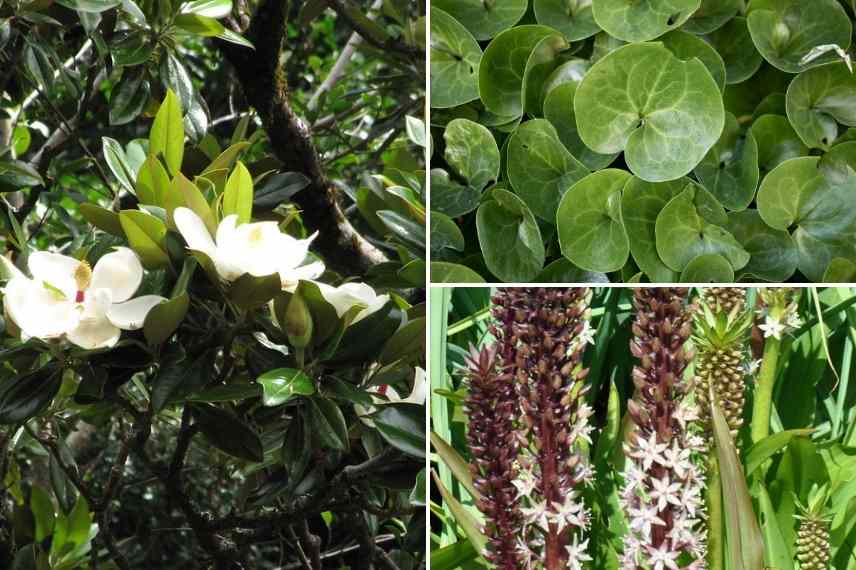
Discover other Magnolia
View all →Available in 0 sizes
Available in 1 sizes
Available in 1 sizes
Available in 1 sizes
Available in 1 sizes
Available in 1 sizes
Available in 1 sizes
Available in 1 sizes
Available in 1 sizes
Available in 1 sizes
In a white garden
Whiteness and cream tones of many Magnolia species naturally lend them to white monochrome gardens. They become stars there, especially when chosen for spring flowering on naked wood, such as the delightful Magnolia loebnieri ‘Wildcat’ —very slightly pink—or the classic Magnolia stellata. Magnolia sieboldii , a little less well-known and with superb purple-centred flowers, is also very much at home in a white-dominated border. To respect this colour palette, combine some elegant perennials and bushes that will flower at the same time, and right up to frosts: some daffodils, a white Rhododendron such as the spectacular ‘Cunningham’s White’, a Viburnum plicatum ‘Mariesii’ which will take over in May with Papaver orientale, a Cornus kousa, a mock orange, Madonna lilies, Echinops ritro ‘White Globe’, the Japanese anemone ‘Honorine Jobert’ in autumn, heathers (Erica darleyensis ‘Sliberschmelze’) and some oriental hellebores for winter. Compose your garden with a very wide white palette, from bulbs up to ornamental trees, taking care to combine foliage in contrasting greens.
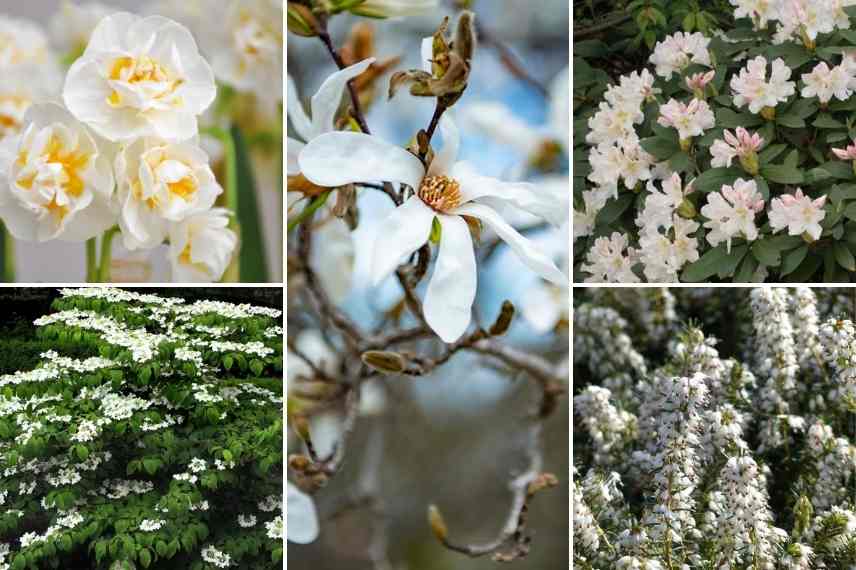
Magnolia stellata accompanied by spring daffodils, a viburnum ‘Mariesii‘, Rhododendron ‘Cunnigham’s White’ and winter heath ‘Silberschmelze’
In a springtime scene
In a large country garden, the pink of a Magnolia ‘Galaxy’ or of a Magnolia campbellii x liliifora ‘Star Wars’, or the delightful yellow of Magnolia x stellata ‘Gold Star’ can simply be surrounded by spring bulbs that will highlight all their charms at flowering time. Use botanical daffodils, hyacinths, tulips and fritillaries liberally, creating large flowering drifts around the Magnolia. This low stratum is sufficient to showcase the tree in an open area on a short grass meadow or on a large meadow. Mix early- and late-flowering periods of these bulbous plants to obtain an attractive display over several weeks. Juneberry will accompany your deciduous Magnolia beautifully. By planting a bush that flowers just after your Magnolia, the result is wonderfully bucolic into May — for example a Japanese cherry such as Prunus serrulata ‘Kanzan’ with its spectacular double pink flowers, or Prunus serrulata ‘Pink Perfection’.
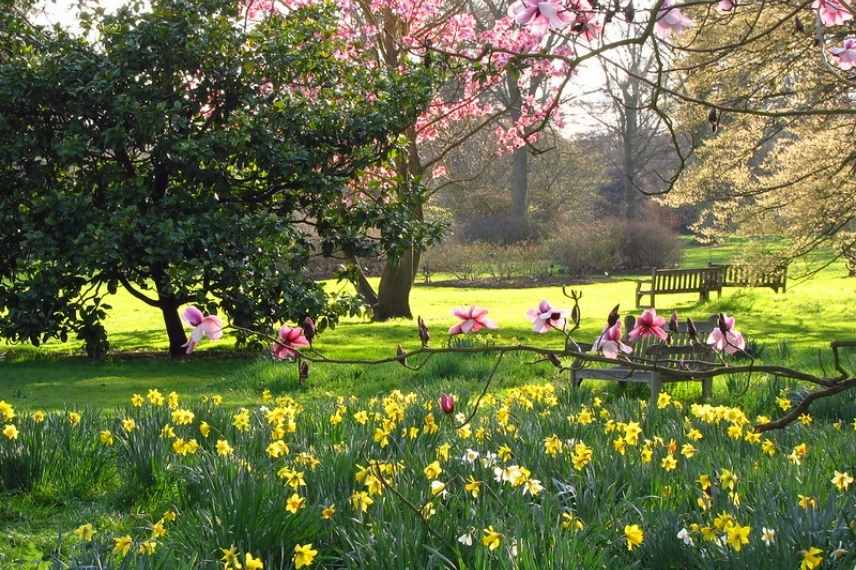
Spring scene combining Magnolias and mass-planted daffodils
(© Laura Nolte)
In a bed of heather soil
Magnolias thrive in acidic ground, they easily find their place in a heather soil bed. Choose for this type of bed a medium-sized Magnolia, such as a Magnolia ‘Susan’ or Magnolia soulangeana ‘Rustica Rubra’. Provided they are planted in a spot that receives enough sun – since Magnolia needs more sun compared with plants found in such a bed – it will dominate with its elegant habit trained as coppice shoots of Chinese Azaleas (they tolerate sun better than their Chinese cousins) such as the azalea ‘Jolie Madame’ pink with an orange throat, or the Azalea ‘Persil’ white maculate with golden yellow. No need to multiply species here either, which will always be acidophilous: a few summer heathers will provide a beautiful evergreen, colourful carpet for many months. Ferns tolerating a bright exposure such as Blechnum spicant or Pteridium aquilinum will complete this pretty scene.
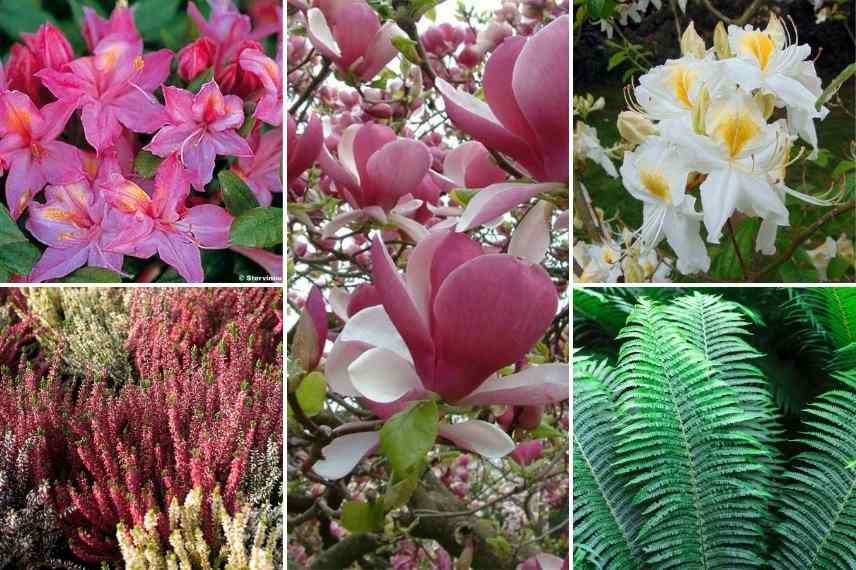
A Magnolia soulangeana ‘Rustica Rubra’ in perfect harmony with Chinese Azaleas ‘Jolie Madame’ and ‘Persil’, and carpets of Calluna and Pteridium aquilinum
In shades of yellow
Old varieties and very recent cultivars give Magnolias splendid yellow colours it would be a pity to miss when creating schemes in this luminous or often subtle tone among Magnolias. You can then create a sumptuous yellow scene toned with white, coppery or bluish hues… Choose the superb Magnolia ‘Elisabeth’ with its very soft, delightfully scented yellow, Magnolia ‘Honey Tulip’, Magnolia acuminata ‘Butterfly’, or Magnolia brooklynensis ‘Yellow Bird’.
To anchor this yellow scheme, try the lovely Chinese Azalea ‘Harvest Moon’ in very pale yellow or Rhododendron ‘Horizon Monarch’ slightly tinged with apricot, and an Euphorbia characias to add a tart note to this flower bed for many weeks. Some botanical tulips neustruevae, a magnificent golden yellow, will lift the whole scheme in early spring and a group of late tulips such as the bright, dentate ‘Maja’ will flower in May. Phlomis russeliana will bring silvery evergreen foliage as well as handsome spring yellow flowers, Alchemillas will provide soft, downy foliage and a lighter, tangy flowering, and lupins ‘Le Chandelier’ in yellow will brighten summer months.
In coppery to purplish touches, I recommend the attractive Heucherella ‘Sweet Tea’, a few Geum ‘Mai Tai’ which will bring a lovely salmon effect, and a compact bush such as Physocarpus opulifolius ‘Diable d’Or’. If you prefer to pair bluish notes with purple, an Acer Palmatum ‘Atropurpureus’ will provide strong contrast to yellow flowering, while a Rhododendron ‘Blue Silver’, Siberian Iris ‘Perry’s Blue’, and liriope will flower in bluish to violet tones.

An elegant Magnolia brooklynensis ‘Yellow Bird’ at centre (© Wendy Cutler) in a coppery yellow border: Geum ‘Mai Tai’, Chinese Azalea ‘Harvest Moon’, Euphorbia characias and Heucherella ‘Sweet Tea’
In pots
Magnolias are small bushes that generally become trees at maturity. They therefore naturally establish and thrive in the ground, but they grow slowly and several varieties remain small, which allows some to be planted in large pots. You can thus enjoy their absolute delicacy on a large terrace ideally facing west or south to receive enough light, and above all sheltered from prevailing winds. You will need a large tub or container.
Undoubtedly the most suitable cultivar is Magnolia stellata, the star magnolia: it reaches up to 3 m tall, has a superb small spreading habit, very ramified, which is perfect for container planting. Despite its slow development like all Magnolias, it flowers fairly young, producing an abundant star-shaped flowering of pure white on the naked wood in March–April. It is a beauty not to be missed if you have a well-exposed terrace. The Magnolia stellata ‘Waterlily’ is also very suitable. Plant at its base some low perennials or annuals that will dress the pot for a long time once the bush has finished flowering: Globularia trichosantha, Ageratums, Lithodoras, Godetias or Coreopsis.
Another variety interesting for a large container is the magnificent Magnolia grandiflora ‘Little Gem’, evergreen, offering a summer flowering (2.50 m tall). The charming and very floriferous Michelia ‘Fairy Lime’, at 2.50 m tall, can also be grown in large pots.
→ Discover our advice sheet: Grow a magnolia in a pot

A Michelia ‘Fairy Lime’ superb in a container, with some low perennials and annuals that will take over: Globularia trichosantha and Ageratums in summer
- Subscribe!
- Contents










































Comments